-

开展身边的榜样活动总结
活动不仅要让人们看到身边的榜样的光辉事迹,更要让更多的人从中受益,激发更多的人的积极性和创造力。其次,我们需要注重活动的针对性和个性化。不同地区、不同职业、不同年龄段的人,对身边的榜样的需求和关注点都不同。因此,我们需要根据不同的需求,来设计和实施不同的活动,让更多的人从中受益。最后,我们需要注重活动的合作性和协同性。开展身边的榜样活动,需要各个方面的支持和协作,需要各个部门和机构的共同努力,才能取得更好的效果和成果。开展身边的榜样活动是一个非常有意义和有价值的事情。通过宣传、表彰和学习身边的榜样,我们可以激励更多的人为社会作出更大的贡献,促进社会和谐发展。希望更多的人能够参与到身边的榜样活动中来,让我们共同努力,让身边的榜样成为我们学习、学习和效仿的楷模。

在知识竞赛上的总结讲话
二是制度执行不到位,三是工作作风浮躁。公司安全总监主观上以暑假期间维稳减小社会影响为由未及时上报,客观上加大了问题的严重性。这些隐患问题在刚才的竞赛中也有提到。三条人命就这样没了?这是意外吗?我觉得不是,如果作业职工能按章操作,相关部门安规监督,这样的事故是完全可以避免的。由此说来,提升安全健康意识和落实安全健康行动是必须的、必要的,否则发生事故就是必然的。所以各位,要引以为戒呀,要长敲警钟啊,切不可麻痹大意、因小失大,造成无法弥补的损失。职工朋友们,竞赛结束了,但是我们的工作还在继续,我们的“战斗”仍在继续。我们要以本次XX杯知识竞赛为起点,继续做好XXXX,继续打好“二次创业”的接力战,为企业安全健康发展立新功、创新业、开新路。
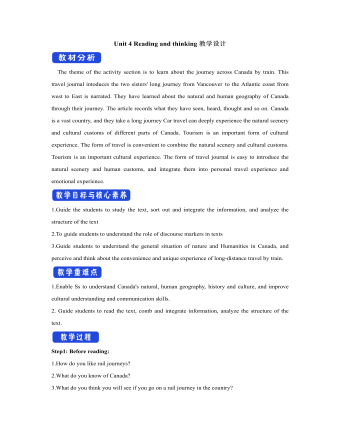
新人教版高中英语选修2Unit 4 Reading and thinking教学设计
【词汇精讲】highlight n.最好或最精彩的部分 vt.突出;强调;使醒目One of the highlights of the trip was seeing the Taj Mahal.这次旅行的亮点之一是参观泰姬陵。Your resume should highlight your skills and achievements.你的简历应该突出你的技能和成就。The report highlights the major problems facing society today.报告强调了当今社会所面临的主要问题。I’ve highlighted the important passages in yellow.我用黄色标出了重要段落。7.Edmonton is freezing cold in winter,with daily temperatures averaging -10 ℃.埃德蒙顿冬季寒冷,日平均气温为-10°C。【词汇精讲】freezing adj.极冷的;冰冻的Leave a basin of water outside in freezing weather.在冰冻的天气里,放一盆水在室外。It’s freezing cold outside so wear a warm coat.外面超冷的,所以穿一个暖和一点的外套吧。8.It was not until 9:30 a.m.that they finally reached the capital of Ontario,Toronto.直到上午9时30分,他们才终于到达多伦多的首府安大略省。【句式剖析】本句是一个强调句,强调的是句子的时间状语until 9:30。含有not...until...的句子的强调句为It is not until...that...,that后面的句子要用肯定形式。It was not until then that I suddenly realized nobody was happier than I was.直到那时我才突然意识到没有人比我更幸福了。
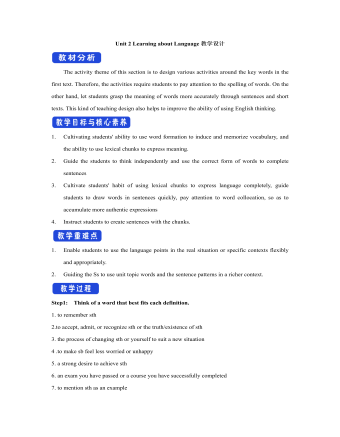
新人教版高中英语选修2Unit 2 Learning about Language教学设计
The activity theme of this section is to design various activities around the key words in the first text. Therefore, the activities require students to pay attention to the spelling of words. On the other hand, let students grasp the meaning of words more accurately through sentences and short texts. This kind of teaching design also helps to improve the ability of using English thinking.1. Cultivating students' ability to use word formation to induce and memorize vocabulary, and the ability to use lexical chunks to express meaning.2. Guide the students to think independently and use the correct form of words to complete sentences3. Cultivate students' habit of using lexical chunks to express language completely, guide students to draw words in sentences quickly, pay attention to word collocation, so as to accumulate more authentic expressions4. Instruct students to create sentences with the chunks.1. Enable students to use the language points in the real situation or specific contexts flexibly and appropriately.2. Guiding the Ss to use unit topic words and the sentence patterns in a richer context.Step1: Think of a word that best fits each definition.1. to remember sth2.to accept, admit, or recognize sth or the truth/existence of sth3. the process of changing sth or yourself to suit a new situation4 .to make sb feel less worried or unhappy5. a strong desire to achieve sth
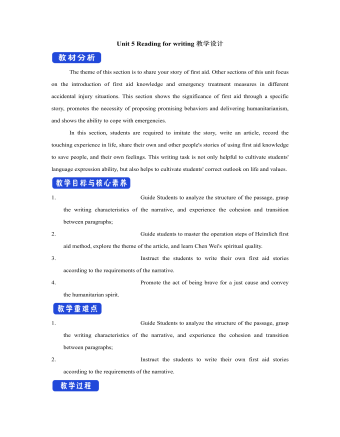
新人教版高中英语选修2Unit 5 Reading for writing教学设计
你校英语报计划出版一期急救常识专刊,现面向全校学生公开征集稿件,你有意参加。请你根据下面提示内容,用英语写一篇短文,介绍在车祸现场对伤者进行急救的方法和步骤。1.确保现场的安全;2.询问伤者,确保其呼吸正常;3.检查伤口,如流血则应采取止血措施;4.如需急救,确保其处于康复位置。注意:1.词数80左右;2.可以适当增加细节,以使行文连贯。参考词汇:康复位置 recovery positionAs we all know, having a knowledge of first aid can make a great difference in our daily life. If a traffic accident happens and someone is injured, the following steps can be used to treat the injured.In the first place, we should make sure that the accident scene is safe so that we won’t get hurt. We should ask the injured person if he is OK, and see if he is breathing. What’s more, we should check for cuts and wounds. If he is bleeding badly, it is vital that we should try to stop the bleeding by applying pressure to the injury. This is because if a person loses too much blood, he may die. If necessary, take the injured person to the hospital as soon as possible.Do remember: when giving first aid, please be sure to place the person in a recovery position.
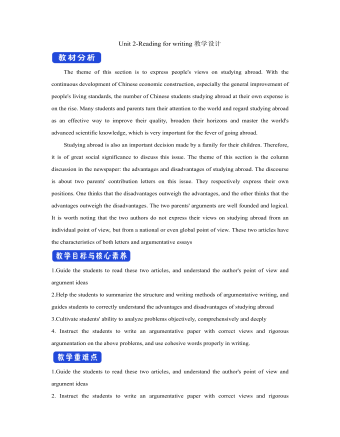
新人教版高中英语选修2Unit 2 Reading for writing教学设计
The theme of this section is to express people's views on studying abroad. With the continuous development of Chinese economic construction, especially the general improvement of people's living standards, the number of Chinese students studying abroad at their own expense is on the rise. Many students and parents turn their attention to the world and regard studying abroad as an effective way to improve their quality, broaden their horizons and master the world's advanced scientific knowledge, which is very important for the fever of going abroad. Studying abroad is also an important decision made by a family for their children. Therefore, it is of great social significance to discuss this issue. The theme of this section is the column discussion in the newspaper: the advantages and disadvantages of studying abroad. The discourse is about two parents' contribution letters on this issue. They respectively express their own positions. One thinks that the disadvantages outweigh the advantages, and the other thinks that the advantages outweigh the disadvantages. The two parents' arguments are well founded and logical. It is worth noting that the two authors do not express their views on studying abroad from an individual point of view, but from a national or even global point of view. These two articles have the characteristics of both letters and argumentative essays1.Guide the students to read these two articles, and understand the author's point of view and argument ideas2.Help the students to summarize the structure and writing methods of argumentative writing, and guides students to correctly understand the advantages and disadvantages of studying abroad3.Cultivate students' ability to analyze problems objectively, comprehensively and deeply
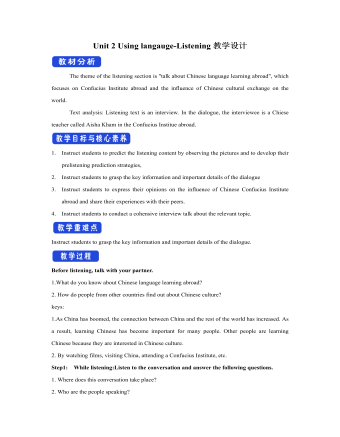
新人教版高中英语选修2Unit 2 Using langauge-Listening教学设计
? B: Absolutely! Getting involved with Chinese cultural activities there definitely helped a lot. I got to practice my Chinese on a daily basis, and I could learn how native Chinese speakers spoke.? A: What do you feel is your biggest achievement?? B: Learning Chinese characters! I have learnt about 1,500 so far. When I first started, I didn't think it was even going to be possible to learn so many, but now I find that I can read signs, menus, and even some easy newspaper articles.? A: What are you most keen on?? B: I've really become keen on learning more about the Chinese culture, in particular Chinese calligraphy. As I have learnt Chinese characters, I have developed a great appreciation for their meaning. I want to explore Chinese characters by learning how to write them in a more beautiful way. ? A: Finally, what do you want to say to anyone interested in learning Chinese?? I have really become keen on learning more about the Chinese culture, in particular Chinese Calligraphy. As I have learnt Chinese character, I have developed a great appreciation for their meaning. I want to explore Chinese characters by learning how to write them in a more beautiful way.? A: Finally, what do you want to say to anyone interested in learning Chinese?? B: I'd say, give it a shot! While some aspects may be difficult, it is quite rewarding and you will be happy that you tried.? A: Thanks for your time. ? B:You're welcome.
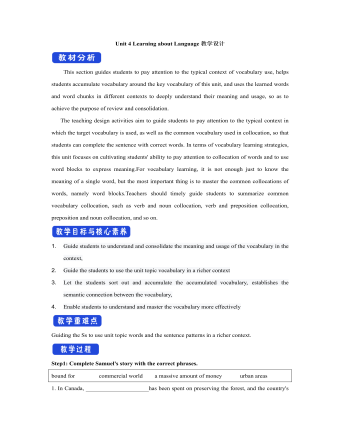
新人教版高中英语选修2Unit 4 Learning about Language教学设计
This section guides students to pay attention to the typical context of vocabulary use, helps students accumulate vocabulary around the key vocabulary of this unit, and uses the learned words and word chunks in different contexts to deeply understand their meaning and usage, so as to achieve the purpose of review and consolidation.The teaching design activities aim to guide students to pay attention to the typical context in which the target vocabulary is used, as well as the common vocabulary used in collocation, so that students can complete the sentence with correct words. In terms of vocabulary learning strategies, this unit focuses on cultivating students' ability to pay attention to collocation of words and to use word blocks to express meaning.For vocabulary learning, it is not enough just to know the meaning of a single word, but the most important thing is to master the common collocations of words, namely word blocks.Teachers should timely guide students to summarize common vocabulary collocation, such as verb and noun collocation, verb and preposition collocation, preposition and noun collocation, and so on.1. Guide students to understand and consolidate the meaning and usage of the vocabulary in the context, 2. Guide the students to use the unit topic vocabulary in a richer context3. Let the students sort out and accumulate the accumulated vocabulary, establishes the semantic connection between the vocabulary,4. Enable students to understand and master the vocabulary more effectivelyGuiding the Ss to use unit topic words and the sentence patterns in a richer context.
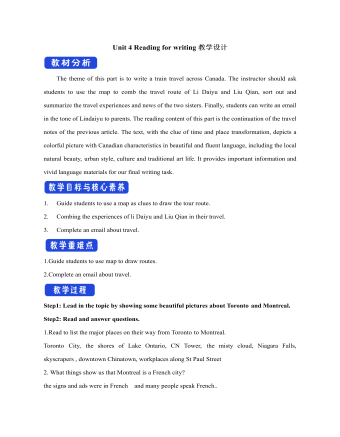
新人教版高中英语选修2Unit 4 Reading for writing教学设计
假定你是英国的Jack,打算来中国旅行,请你给你的中国笔友李华写一封信,要点如下:1.你的旅行计划:北京→泰山→杭州;2.征求建议并询问他是否愿意充当你的导游。注意:1.词数80左右(开头和结尾已给出,不计入总词数);2.可以适当增加细节,以使行文连贯。参考词汇:故宫 the Forbidden City;泰山 Mount TaiDear Li Hua,I'm glad to tell you that 'm going to visit China.First,I am planning to visit Beijing,the capitalof China,where I am looking forward to enjoying the Great Wall,the Forbidden City and somebeautiful parks.Then I intend to go to visit Mount Tai in Shandong Province.I've heard that it is one ofthe most famous mountains in China and I can't wait to enjoy the amazing sunrise there.After that,I amalso going to Hangzhou.It is said that it is a beautiful modern city with breathtaking natural sights,among which the West Lake is a well- known tourist attraction.What do you think of my travel plan? Will you act as my guide? Hope to hear from you soon.

新人教版高中英语选修2Unit 4 Using langauge-Listening教学设计
The theme of the listening section is " talking about scenery and culture along a journey."The part is designed to further lead the students to understand Canadian natural geography and social environment, and integrated into the cultural contrast by mentioning the long train journey from Beijing to Moscow routes. On this basis, the part activates students related travel experience, lets the student serial dialogue, guides the student to explore further the pleasure and meaning of the long journey, and Chinese and foreign cultural comparison.The part also provides a framework for the continuation of the dialogue, which is designed to provide a framework for students to successfully complete their oral expressions, and to incorporate an important trading strategy to end the dialogue naturally.1. Help students to understand and master some common English idioms in the context, and experience the expression effect of English idioms.2. Guide the students to understand the identity of different people in the listening context, and finish the dialogue according to their own experience.3. Instruct the students to use appropriate language to express surprise and curiosity about space and place in the dialogue, and master the oral strategy of ending the dialogue naturally.1. Instruct students to grasp the key information and important details of the dialogue.2. Instruct students to conduct a similar talk on the relevant topic.

新人教版高中英语选修2Unit 5 Learning about Language教学设计
The purpose of this section of vocabulary exercises is to consolidate the key words in the first part of the reading text, let the students write the words according to the English definition, and focus on the detection of the meaning and spelling of the new words. The teaching design includes use English definition to explain words, which is conducive to improving students' interest in vocabulary learning, cultivating their sense of English language and thinking in English, and making students willing to use this method to better grasp the meaning of words, expand their vocabulary, and improve their ability of vocabulary application. Besides, the design offers more context including sentences and short passage for students to practice words flexibly.1. Guide students to understand and consolidate the meaning and usage of the vocabulary in the context, 2. Guide the students to use the unit topic vocabulary in a richer context3. Let the students sort out and accumulate the accumulated vocabulary, establishes the semantic connection between the vocabulary,4. Enable students to understand and master the vocabulary more effectivelyGuiding the Ss to use unit topic words and the sentence patterns in a richer context.Step1: Read the passage about chemical burns and fill in the blanks with the correct forms of the words in the box.
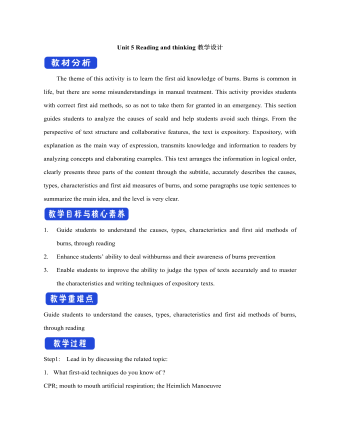
新人教版高中英语选修2Unit 5 Reading and thinking教学设计
The theme of this activity is to learn the first aid knowledge of burns. Burns is common in life, but there are some misunderstandings in manual treatment. This activity provides students with correct first aid methods, so as not to take them for granted in an emergency. This section guides students to analyze the causes of scald and help students avoid such things. From the perspective of text structure and collaborative features, the text is expository. Expository, with explanation as the main way of expression, transmits knowledge and information to readers by analyzing concepts and elaborating examples. This text arranges the information in logical order, clearly presents three parts of the content through the subtitle, accurately describes the causes, types, characteristics and first aid measures of burns, and some paragraphs use topic sentences to summarize the main idea, and the level is very clear.1. Guide students to understand the causes, types, characteristics and first aid methods of burns, through reading2. Enhance students’ ability to deal withburnss and their awareness of burns prevention3. Enable students to improve the ability to judge the types of texts accurately and to master the characteristics and writing techniques of expository texts.Guide students to understand the causes, types, characteristics and first aid methods of burns, through readingStep1: Lead in by discussing the related topic:1. What first-aid techniques do you know of ?CPR; mouth to mouth artificial respiration; the Heimlich Manoeuvre

新人教版高中英语选修2Unit 5 Using langauge-Listening教学设计
The theme of this section is to learn how to make emergency calls. Students should learn how to make emergency calls not only in China, but also in foreign countries in English, so that they can be prepared for future situations outside the home.The emergency telephone number is a vital hotline, which should be the most clear, rapid and effective communication with the acute operator.This section helps students to understand the emergency calls in some countries and the precautions for making emergency calls. Through the study of this section, students can accumulate common expressions and sentence patterns in this context. 1.Help students accumulate emergency telephone numbers in different countries and learn more about first aid2.Guide the students to understand the contents and instructions of the telephone, grasp the characteristics of the emergency telephone and the requirements of the emergency telephone.3.Guide students to understand the first aid instructions of the operators.4.Enable Ss to make simulated emergency calls with their partners in the language they have learned1. Instruct students to grasp the key information and important details of the dialogue.2. Instruct students to conduct a similar talk on the relevant topic.Step1:Look and discuss:Match the pictures below to the medical emergencies, and then discuss the questions in groups.
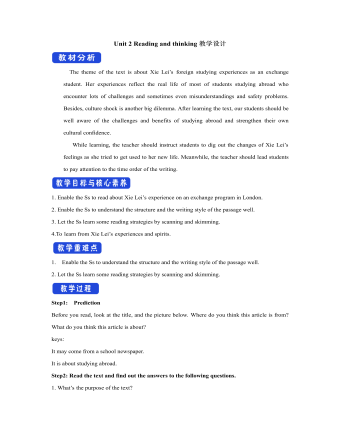
新人教版高中英语选修2Unit 2 Reading and thinking教学设计
Her tutor told her to acknowledge __________ other people had said if she cited their ideas, and advised her _______(read) lots of information in order to form __________wise opinion of her own.Now halfway __________ her exchange year, Xie Lei felt much more at home in the UK. She said __________ (engage) in British culture had helped and that she had been__________ (involve) in social activities. She also said while learning about business, she was acting as a cultural messenger __________(build) a bridge between the two countries. keys:Xie Lei, a 19yearold Chinese student, said goodbye to her family and friends in China and boarded (board) a plane for London six months ago in order to get a business qualification. She was ambitious(ambition) to set up a business after graduation. It was the first time that she had left (leave) home.At first, Xie Lei had to adapt to life in a different country. She chose to live with a host family, who can help with her adaptation (adapt) to the new culture. When she missed home, she felt comforted (comfort) to have a second family. Also Xie Lei had to satisfy academic requirements. Her tutor told her to acknowledge what other people had said if she cited their ideas, and advised her to read lots of information in order to form a wise opinion of her own.Now halfway through her exchange year, Xie Lei felt much more at home in the UK. She said engaging (engage) in British culture had helped and that she had been involved (involve) in social activities. She also said while learning about business, she was acting as a cultural messenger building a bridge between the two countries.
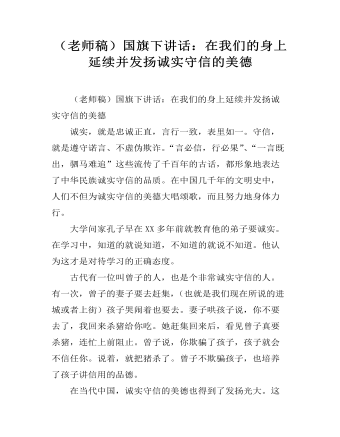
(老师稿)国旗下讲话:在我们的身上延续并发扬诚实守信的美德
在中国,大家都知道两个大名鼎鼎的科学家,他们分别是杨振宁和邓稼先。两个人从小就是好朋友。杨振宁后来留学美国,加入了美国国籍。1964年,我国第一颗原子弹爆炸成功,杨振宁为此感到异常激动。1971年,杨振宁从美国回到祖国,与阔别了整整20多年的好朋友邓稼先见面,杨振宁很想知道邓稼先是否参与了中国第一颗原子弹的研究,于是间接地问:“听说中国研究原子弹的专家中有一个美国人,是吗?”邓稼先感到很为难,于是想出了一个既没有泄露国家机密又没有欺骗朋友的办法,对杨振宁说:“我以后再告诉你吧!”。邓稼先就是这样一个诚实的人,无论是对国家,还是对朋友,都是如此。我们懂得了为什么要提倡诚实守信的道理之后,我们还要知道怎样做到诚实守信。要做到诚实守信,需要我们从现在做起,从自己做起,从日常的生活小事做起,人人讲信用,时时讲信用,共同构造一个信用的社会。
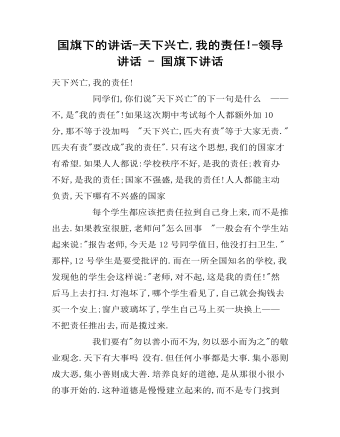
国旗下的讲话-天下兴亡,我的责任!-领导讲话 - 国旗下讲话
天下兴亡,我的责任! 同学们,你们说"天下兴亡"的下一句是什么 ——不,是"我的责任"!如果这次期中考试每个人都额外加10分,那不等于没加吗 "天下兴亡,匹夫有责"等于大家无责."匹夫有责"要改成"我的责任".只有这个思想,我们的国家才有希望.如果人人都说:学校秩序不好,是我的责任;教育办不好,是我的责任;国家不强盛,是我的责任!人人都能主动负责,天下哪有不兴盛的国家每个学生都应该把责任拉到自己身上来,而不是推出去.如果教室很脏,老师问"怎么回事 "一般会有个学生站起来说:"报告老师,今天是12号同学值日,他没打扫卫生."那样,12号学生是要受批评的.而在一所全国知名的学校,我发现他的学生会这样说:"老师,对不起,这是我的责任!"然后马上去打扫.灯泡坏了,哪个学生看见了,自己就会掏钱去买一个安上;窗户玻璃坏了,学生自己马上买一块换上——不把责任推出去,而是揽过来.我们要有"勿以善小而不为,勿以恶小而为之"的敬业观念.天下有大事吗 没有.但任何小事都是大事.集小恶则成大恶,集小善则成大善.培养良好的道德,是从那很小很小的事开始的.这种道德是慢慢建立起来的,而不是专门找到大事才干.天下无大事,请先把自己脚下的纸屑捡起来——这就是我们要做的事.
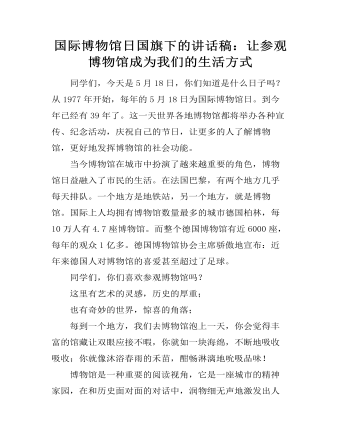
国际博物馆日国旗下的讲话稿:让参观博物馆成为我们的生活方式
同学们,今天是5月18日,你们知道是什么日子吗?从1977年开始,每年的5月18日为国际博物馆日。到今年已经有39年了。这一天世界各地博物馆都将举办各种宣传、纪念活动,庆祝自己的节日,让更多的人了解博物馆,更好地发挥博物馆的社会功能。当今博物馆在城市中扮演了越来越重要的角色,博物馆日益融入了市民的生活。在法国巴黎,有两个地方几乎每天排队。一个地方是地铁站,另一个地方,就是博物馆。国际上人均拥有博物馆数量最多的城市德国柏林,每10万人有4.7座博物馆。而整个德国博物馆有近6000座,每年的观众1亿多。德国博物馆协会主席骄傲地宣布:近年来德国人对博物馆的喜爱甚至超过了足球。同学们,你们喜欢参观博物馆吗?这里有艺术的灵感,历史的厚重;也有奇妙的世界,惊喜的角落;
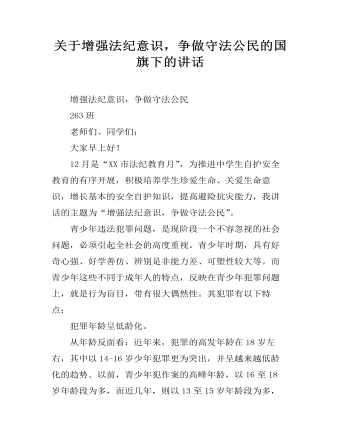
关于增强法纪意识,争做守法公民的国旗下的讲话
增强法纪意识,争做守法公民263班老师们、同学们:大家早上好!12月是“XX市法纪教育月”,为推进中学生自护安全教育的有序开展,积极培养学生珍爱生命、关爱生命意识,增长基本的安全自护知识,提高避险抗灾能力,我讲话的主题为“增强法纪意识,争做守法公民”。青少年违法犯罪问题,是现阶段一个不容忽视的社会问题,必须引起全社会的高度重视。青少年时期,具有好奇心强、好学善仿、辨别是非能力差、可塑性较大等。而青少年这些不同于成年人的特点,反映在青少年犯罪问题上,就是行为盲目,带有很大偶然性。其犯罪有以下特点:犯罪年龄呈低龄化。从年龄反面看:近年来,犯罪的高发年龄在18岁左右,其中以14-16岁少年犯罪更为突出,并呈越来越低龄化的趋势。
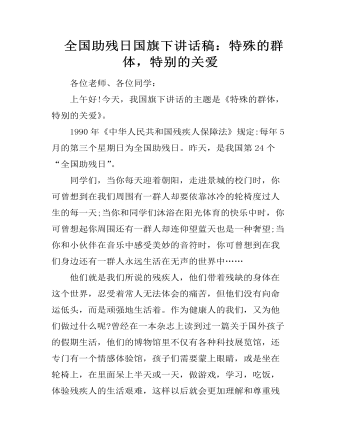
全国助残日国旗下讲话稿:特殊的群体,特别的关爱
各位老师、各位同学:上午好!今天,我国旗下讲话的主题是《特殊的群体,特别的关爱》。1990年《中华人民共和国残疾人保障法》规定:每年5月的第三个星期日为全国助残日。昨天,是我国第24个“全国助残日”。同学们,当你每天迎着朝阳,走进景城的校门时,你可曾想到在我们周围有一群人却要依靠冰冷的轮椅度过人生的每一天;当你和同学们沐浴在阳光体育的快乐中时,你可曾想起你周围还有一群人却连仰望蓝天也是一种奢望;当你和小伙伴在音乐中感受美妙的音符时,你可曾想到在我们身边还有一群人永远生活在无声的世界中……他们就是我们所说的残疾人,他们带着残缺的身体在这个世界,忍受着常人无法体会的痛苦,但他们没有向命运低头,而是顽强地生活着。作为健康人的我们,又为他们做过什么呢?曾经在一本杂志上读到过一篇关于国外孩子的假期生活,他们的博物馆里不仅有各种科技展览馆,还专门有一个情感体验馆,孩子们需要蒙上眼睛,或是坐在轮椅上,在里面呆上半天或一天,做游戏,学习,吃饭,体验残疾人的生活艰难,这样以后就会更加理解和尊重残疾人。

人教版高中数学选修3离散型随机变量及其分布列(2)教学设计
温故知新 1.离散型随机变量的定义可能取值为有限个或可以一一列举的随机变量,我们称为离散型随机变量.通常用大写英文字母表示随机变量,例如X,Y,Z;用小写英文字母表示随机变量的取值,例如x,y,z.随机变量的特点: 试验之前可以判断其可能出现的所有值,在试验之前不可能确定取何值;可以用数字表示2、随机变量的分类①离散型随机变量:X的取值可一、一列出;②连续型随机变量:X可以取某个区间内的一切值随机变量将随机事件的结果数量化.3、古典概型:①试验中所有可能出现的基本事件只有有限个;②每个基本事件出现的可能性相等。二、探究新知探究1.抛掷一枚骰子,所得的点数X有哪些值?取每个值的概率是多少? 因为X取值范围是{1,2,3,4,5,6}而且"P(X=m)"=1/6,m=1,2,3,4,5,6.因此X分布列如下表所示

